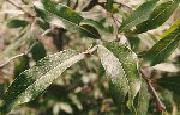

Common Name: Diamond-leaf
Willow, Sura
Genus: Salix
Species: pulcha
Parts Used: the leaves

The twigs on a willow are soft, slender, and they bend easily. A willow has thin branches. The leaves are narrow and grow alternately on the branch. Some leaves have serrated edges.
There are many different species of willows in the world. They can grow to be 30 feet in height or just a few inches. On the tundra this willow only grows a few inches tall and creeps along the ground in a thick carpet. Willows have clusters of flowers that look like white, fuzzy caterpillars and are about 1 inch in length. When the willow blooms on the tundra it looks like a bumpy, fuzzy carpet covering the ground
On the tundra the diamond-leaf willow is known by the Inupiat name Sura. Sura grows near creeks, marshes or other wet areas. Young leaves are picked in the spring, before they become bitter and hard. They can be used in seal oil to add vitamins. Seal oil is also used to preserve the leaves. Willow leaves can also be dried and used in tea and in soup as flavoring.
Amazingly enough, Sura is 10 times richer in vitamin C than oranges. It is also rich in vitamin A and calcium. Willow leaves are a good source of nutrients for animals and people of the tundra.
The twigs of the willow are made into baskets because they bend easily. The wood of some willows produce charcoal which they used to make gunpowder with. Wood from the willow is good to use to start a fire, since it burns easily.
The diamond leaf willow provides much needed food for grazing animal of the tundra, like musk oxen, and caribou or reindeer.
These plants are found in most parts of the world, usually in the northern hemisphere. The white willow (Salix alba) is know as Nature's Aspirin. The chemical salicin is found in the bark of the white willow. It reduces fever and relieves pain and inflammation. Chinese physicians have been using willow bark to relieve pain for 2,000 years.
Eliot T. 2000.
Bibliography:
"leaves", http://www.nsbsd.k12.ak.us/projects/pho_botany/leaves.htm , (July 2000).
*Check this link out
for great information!
http://www.nsbsd.k12.ak.us/projects/projects.htm,
(Sept. 2000).
"Herbal Remedies -- White Willow: the herbal aspirin" http://www.healthyideas.com/healing/herb/rem/whwillow.html , (July 2000).